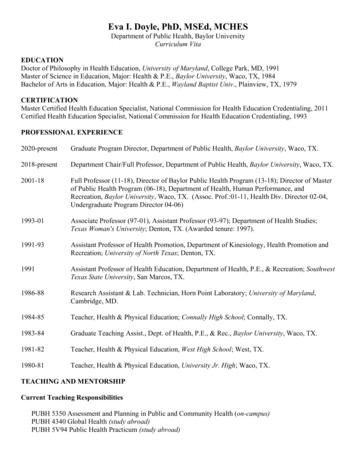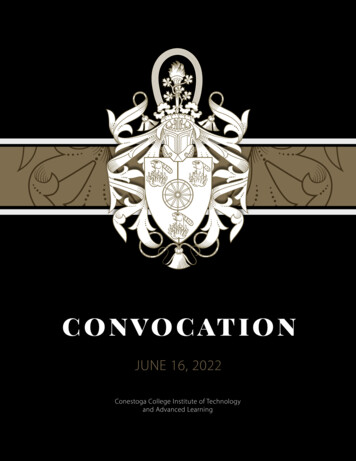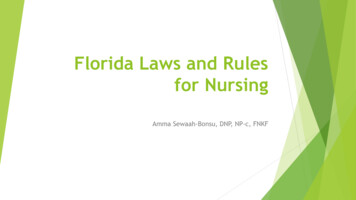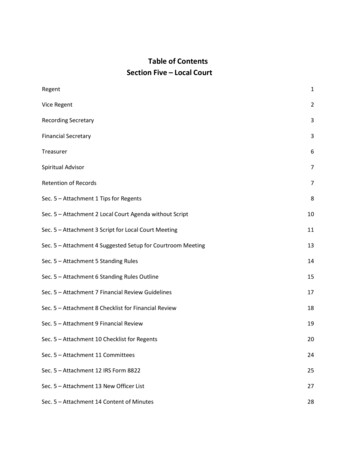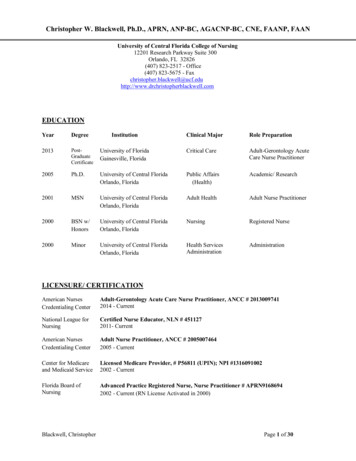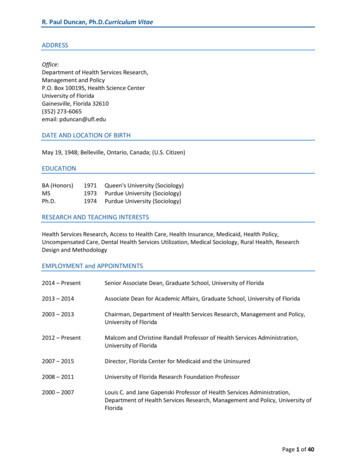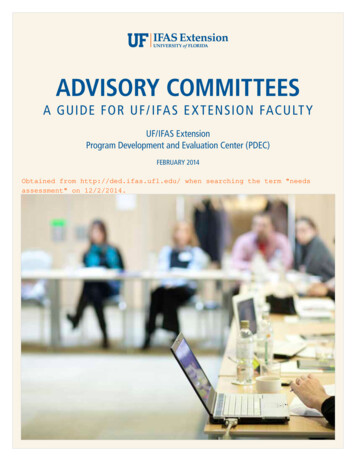
Transcription
ADVISORY COMMITTEESA GUIDE FOR UF / IFA S E X TENSION FACULT YUF/IFAS ExtensionProgram Development and Evaluation Center (PDEC)FEBRUARY 2014Obtained from http://ded.ifas.ufl.edu/ when searching the term "needsassessment" on 12/2/2014.
A special thanks to New Mexico State University Extensionfor the use of sections from Handbook for Working with Advisory Committees(revised 2004) located at http://pda.nmsu.edu.
A D V I S O RY C O M M I T T E E S : A G U I D E F O R U F / I FA S E X T E N S I O N FA C U LT YTable of ContentsIntroduction . . . . . . . . . . . . . . . . . . . . . . . . . . . . . . . . . . . . . . . . . . . . . . . . . . . . . . . . . . . . . . . . . . . . . . . . . . . . . . . . . . . . . . . . . . . . . . . . . . . . . . . . . . . . . . . . . . . . 4Purpose of the Advisory Committee . . . . . . . . . . . . . . . . . . . . . . . . . . . . . . . . . . . . . . . . . . . . . . . . . . . . . . . . . . . . . . . . . . . . . . . . . . . . . . . . . . . . . . . . . . . . . . 4Roles of the Advisory Committee. . . . . . . . . . . . . . . . . . . . . . . . . . . . . . . . . . . . . . . . . . . . . . . . . . . . . . . . . . . . . . . . . . . . . . . . . . . . . . . . . . . . . . . . . . . . . . . . . 5Roles of Faculty . . . . . . . . . . . . . . . . . . . . . . . . . . . . . . . . . . . . . . . . . . . . . . . . . . . . . . . . . . . . . . . . . . . . . . . . . . . . . . . . . . . . . . . . . . . . . . . . . . . . . . . . . . . . . 5Expectations of the Advisory Team: Who is doing the work?. . . . . . . . . . . . . . . . . . . . . . . . . . . . . . . . . . . . . . . . . . . . . . . . . . . . . . . . . . . . . . . . . . 5Affirmative Action and Parity. . . . . . . . . . . . . . . . . . . . . . . . . . . . . . . . . . . . . . . . . . . . . . . . . . . . . . . . . . . . . . . . . . . . . . . . . . . . . . . . . . . . . . . . . . . . . . . . . . . . . 6Affirmative Action Compliance and Managing Advisory Committees . . . . . . . . . . . . . . . . . . . . . . . . . . . . . . . . . . . . . . . . . . . . . . . . . . . . . . . . . 6Parity. . . . . . . . . . . . . . . . . . . . . . . . . . . . . . . . . . . . . . . . . . . . . . . . . . . . . . . . . . . . . . . . . . . . . . . . . . . . . . . . . . . . . . . . . . . . . . . . . . . . . . . . . . . . . . . . . . . . . . . 6Identifying the baseline demographics . . . . . . . . . . . . . . . . . . . . . . . . . . . . . . . . . . . . . . . . . . . . . . . . . . . . . . . . . . . . . . . . . . . . . . . . . . . . . . . . . . . . . . . 7Structure of the Advisory Committee. . . . . . . . . . . . . . . . . . . . . . . . . . . . . . . . . . . . . . . . . . . . . . . . . . . . . . . . . . . . . . . . . . . . . . . . . . . . . . . . . . . . . . . . . . . . . 7Traditional or Inclusive? Two Effective Model Structures . . . . . . . . . . . . . . . . . . . . . . . . . . . . . . . . . . . . . . . . . . . . . . . . . . . . . . . . . . . . . . . . . . . . . 7The Structure of a Traditional Florida Advisory Committee . . . . . . . . . . . . . . . . . . . . . . . . . . . . . . . . . . . . . . . . . . . . . . . . . . . . . . . . . . . . . . . . . . . 8Components of an Advisory Committee. . . . . . . . . . . . . . . . . . . . . . . . . . . . . . . . . . . . . . . . . . . . . . . . . . . . . . . . . . . . . . . . . . . . . . . . . . . . . . . . . . . . . . 8Logistics of an Effective Advisory Committee. . . . . . . . . . . . . . . . . . . . . . . . . . . . . . . . . . . . . . . . . . . . . . . . . . . . . . . . . . . . . . . . . . . . . . . . . . . . . . . . 9Number. . . . . . . . . . . . . . . . . . . . . . . . . . . . . . . . . . . . . . . . . . . . . . . . . . . . . . . . . . . . . . . . . . . . . . . . . . . . . . . . . . . . . . . . . . . . . . . . . . . . . . . . . . . . . . . . 9Rotation. . . . . . . . . . . . . . . . . . . . . . . . . . . . . . . . . . . . . . . . . . . . . . . . . . . . . . . . . . . . . . . . . . . . . . . . . . . . . . . . . . . . . . . . . . . . . . . . . . . . . . . . . . . . . . . . 9Selecting and Recruiting Members. . . . . . . . . . . . . . . . . . . . . . . . . . . . . . . . . . . . . . . . . . . . . . . . . . . . . . . . . . . . . . . . . . . . . . . . . . . . . . . . . . . . . . . . . . . . . . 10Member Attributes. . . . . . . . . . . . . . . . . . . . . . . . . . . . . . . . . . . . . . . . . . . . . . . . . . . . . . . . . . . . . . . . . . . . . . . . . . . . . . . . . . . . . . . . . . . . . . . . . . . . . . . . 10Finding Members . . . . . . . . . . . . . . . . . . . . . . . . . . . . . . . . . . . . . . . . . . . . . . . . . . . . . . . . . . . . . . . . . . . . . . . . . . . . . . . . . . . . . . . . . . . . . . . . . . . . . . . . . 11Approaching Potential Members . . . . . . . . . . . . . . . . . . . . . . . . . . . . . . . . . . . . . . . . . . . . . . . . . . . . . . . . . . . . . . . . . . . . . . . . . . . . . . . . . . . . . . . . . . . 11Possible questions from new or potential advisory committee members . . . . . . . . . . . . . . . . . . . . . . . . . . . . . . . . . . . . . . . . . . . . . . . . . . . . . . 12Advisory Committee Training for New Members . . . . . . . . . . . . . . . . . . . . . . . . . . . . . . . . . . . . . . . . . . . . . . . . . . . . . . . . . . . . . . . . . . . . . . . . . . . 12Expectations of Advisory Committee Members. . . . . . . . . . . . . . . . . . . . . . . . . . . . . . . . . . . . . . . . . . . . . . . . . . . . . . . . . . . . . . . . . . . . . . . . . . . . . 13Advisory Committee Meetings. . . . . . . . . . . . . . . . . . . . . . . . . . . . . . . . . . . . . . . . . . . . . . . . . . . . . . . . . . . . . . . . . . . . . . . . . . . . . . . . . . . . . . . . . . . . . . . . .Officers. . . . . . . . . . . . . . . . . . . . . . . . . . . . . . . . . . . . . . . . . . . . . . . . . . . . . . . . . . . . . . . . . . . . . . . . . . . . . . . . . . . . . . . . . . . . . . . . . . . . . . . . . . . . . . . . . . .Meeting Times and Locations . . . . . . . . . . . . . . . . . . . . . . . . . . . . . . . . . . . . . . . . . . . . . . . . . . . . . . . . . . . . . . . . . . . . . . . . . . . . . . . . . . . . . . . . . . . . .Room Arrangements . . . . . . . . . . . . . . . . . . . . . . . . . . . . . . . . . . . . . . . . . . . . . . . . . . . . . . . . . . . . . . . . . . . . . . . . . . . . . . . . . . . . . . . . . . . . . . . . . . . . . .U-Training Arrangement. . . . . . . . . . . . . . . . . . . . . . . . . . . . . . . . . . . . . . . . . . . . . . . . . . . . . . . . . . . . . . . . . . . . . . . . . . . . . . . . . . . . . . . . . . . . . .Problem-Solving Circle . . . . . . . . . . . . . . . . . . . . . . . . . . . . . . . . . . . . . . . . . . . . . . . . . . . . . . . . . . . . . . . . . . . . . . . . . . . . . . . . . . . . . . . . . . . . . . .Long Table for Decision-Making . . . . . . . . . . . . . . . . . . . . . . . . . . . . . . . . . . . . . . . . . . . . . . . . . . . . . . . . . . . . . . . . . . . . . . . . . . . . . . . . . . . . . .Agenda Development. . . . . . . . . . . . . . . . . . . . . . . . . . . . . . . . . . . . . . . . . . . . . . . . . . . . . . . . . . . . . . . . . . . . . . . . . . . . . . . . . . . . . . . . . . . . . . . . . . . . . .1313131414141414Conclusion: Checklist for a Successful Advisory Committee. . . . . . . . . . . . . . . . . . . . . . . . . . . . . . . . . . . . . . . . . . . . . . . . . . . . . . . . . . . . . . . . . . . . . 15References. . . . . . . . . . . . . . . . . . . . . . . . . . . . . . . . . . . . . . . . . . . . . . . . . . . . . . . . . . . . . . . . . . . . . . . . . . . . . . . . . . . . . . . . . . . . . . . . . . . . . . . . . . . . . . . . . . . . . 15Appendices. . . . . . . . . . . . . . . . . . . . . . . . . . . . . . . . . . . . . . . . . . . . . . . . . . . . . . . . . . . . . . . . . . . . . . . . . . . . . . . . . . . . . . . . . . . . . . . . . . . . . . . . . . . . . . . . . . . . 17Appendix I: Timeline for Developing an Extension Advisory Committee . . . . . . . . . . . . . . . . . . . . . . . . . . . . . . . . . . . . . . . . . . . . . . . . . . . . 19Appendix II. Job Description for a Member of a Florida Extension Advisory Committee (sample). . . . . . . . . . . . . . . . . . . . . . . . . . . . . 20Appendix III. Roles of the Overall Advisory Committee (Sample) . . . . . . . . . . . . . . . . . . . . . . . . . . . . . . . . . . . . . . . . . . . . . . . . . . . . . . . . . . . 21Appendix IV. Roles of Extension Advisory Committees by Level. . . . . . . . . . . . . . . . . . . . . . . . . . . . . . . . . . . . . . . . . . . . . . . . . . . . . . . . . . . . . 22Appendix V. Expectations of the Advisory Committee . . . . . . . . . . . . . . . . . . . . . . . . . . . . . . . . . . . . . . . . . . . . . . . . . . . . . . . . . . . . . . . . . . . . . . 23Appendix VI. University of Florida IFAS Extension Affirmative Action Check-Up. . . . . . . . . . . . . . . . . . . . . . . . . . . . . . . . . . . . . . . . . . . . 24Appendix VII. Identifying Potential Advisory Committee Members. . . . . . . . . . . . . . . . . . . . . . . . . . . . . . . . . . . . . . . . . . . . . . . . . . . . . . . . . 34Appendix VIII. Identifying Potential Advisory Committee Members for a New Extension Programmatic Committee. . . . . . . . . . 35Appendix IX. Advisory Membership Grid Overall:. . . . . . . . . . . . . . . . . . . . . . . . . . . . . . . . . . . . . . . . . . . . . . . . . . . . . . . . . . . . . . . . . . . . . . . . . . . . . . . . . . . 36Appendix X: Sample By-laws . . . . . . . . . . . . . . . . . . . . . . . . . . . . . . . . . . . . . . . . . . . . . . . . . . . . . . . . . . . . . . . . . . . . . . . . . . . . . . . . . . . . . . . . . . . . . . 37Appendix XI. Sample Agendas. . . . . . . . . . . . . . . . . . . . . . . . . . . . . . . . . . . . . . . . . . . . . . . . . . . . . . . . . . . . . . . . . . . . . . . . . . . . . . . . . . . . . . . . . . . . . 473
A D V I S O RY C O M M I T T E E S : A G U I D E F O R U F / I FA S E X T E N S I O N FA C U LT YIntroductionPurpose of the AdvisoryCommitteeThis guidebook provides UF/IFAS Extension faculty withdetails on how to develop, implement, and properly engagean advisory committee for effective program planning. AllFlorida county Extension faculty are expected to developand work with advisory committees at the grassroots level.This document provides answers to many of the questionsasked by new faculty about the overall advisory committeestructure, membership and function regardless of theprogram/issue area. Included is information on functionsand roles of the advisory committee membership and ideasto help make your committee as effective and efficient aspossible.Advisory committees have been an important buildingblock in the development of effective UF/IFAS Extensionprograms since the inauguration of the land-grantuniversity concept in Florida almost 100 years ago. Themission statement for the land-grant college includes theCooperative Extension Service mission of “a federal, stateand county partnership dedicated to making knowledgeaccessible to sustain and enhance the quality of humanlife.” Advisory committees are a part of this basic grassrootsphilosophy that provides recommendation in improvingaccessibility to target audiences and the sustainability ofchanges that enhance quality of life.A UF/IFAS Extension advisory committee has a specificpurpose. The committee does not make policy. It is nottask-oriented. The members do not function as Extensionfaculty. The advisory committee has only a few functions,but these are very important to the success of an Extensionprogram:The UF/IFAS Extension advisory committee has twomain purposes: to advise and to advocate. An effectiveand well-developed advisory committee is made up of adiverse membership with the knowledge base needed toprovide the best recommendations for Extension programdevelopment. The committee as advisors can help identifyneeds and issues, target audiences, most the effective waysto reach the target audiences, and the cultural differencesthat need to be understood before developing yourprograms. Because the advisory committee members arepart of the local culture, they are aware of the deeper, moresubtle issues facing the community, and often what causesthem. The advisory committee also can act as advocatesfor the Cooperative Extension Service where Extensionpersonnel are limited in access or where faculty are unableto speak. Committee members can carry the message ofExtension’s mission to all stakeholders and to populationsthat may be difficult for Extension personnel to reach.1. To identify needs/issues within a community orcounty;2. To advise or recommend on how best to reach targetaudiences; and3. When necessary, to act as advocates for Extensionprograms and the UF/IFAS Extension ServiceA well-developed advisory committee has a specialawareness of the needs, attitudes, beliefs and perceptionscommon among people within their communities.Therefore, advisory committees are a strong link betweenthe UF/IFAS Extension and local groups and individuals.They also provide additional credibility to the developmentof new programs and the continuation of others.Extension faculty are managers of change. In everythingthey do, UF/IFAS Extension county faculty are tryingto bring about change to improve the quality of humanlife. Advisory committees can help provide insight intomaking sustainable change happen. They can act as agateway into the acceptance of change by the individualswithin the communities who are learning new techniquesand ideas from Extension faculty. Change can only occurwhen individuals see more value in something new thanwhat they presently have. The advisory committee can helpidentify these values and provide credibility and acceptanceto change.4
A D V I S O RY C O M M I T T E E S : A G U I D E F O R U F / I FA S E X T E N S I O N FA C U LT Y4. Provide orientation and training for committeemembers. It is your responsibility to be sure theyfully understand Extension and the role we play. Theyalso must understand their roles and responsibilitieswithin the broader picture.As the name implies, an advisory committee is meantonly to advise and advocate. These committees are notdesigned to make managerial decisions, nor are they to beempowered to carry out educational programs or collectAffirmative Action data. These are all responsibilities of thecounty faculty and staff.5. Provide leadership and assistance in development ofcommittee operational policies and procedures.To make this purpose clear, there should be a jobdescription for the advisory committee members thatincludes the job title, a job description that clearly statesthe roles and expectations, required qualifications, skillsand the time commitment that will be required to do thejob. The Affirmative Action compliance requirementsshould be clearly stated as part of this document. A samplejob description for committee members is provided in theAppendix on page 20.6. Provide leadership to ensure positive team dynamicsand the management of team diversity within youradvisory committee. If your team doesn’t functionwell together they cannot be successful in anythingthey are trying to do.7. Secure a meeting space.8. Maintain open communication channels.9. Provide necessary information for committeedecision making.Roles of the Advisory Committee10. Provide feedback on results of committee efforts.This includes results of your educational programs.It is important to give some thought to the roles of youradvisory committee before you invite them to join. Notall counties have the same roles. Also, roles may differbased on whether the advisory committee is an overallcommittee or a program area committee. The particularcommodity area within a program area if one exists mayrequire specific roles based on identified needs. The 4-Hadvisory committee members may also have some rolesthat are specific to youth or mandated by federal regulation.Along with this guidebook, 4-H faculty should review the4-H advisory committee handbook (hyperlink to this).A worksheet of possible roles and functions for advisorycommittee members is located in the Appendix on page 22.11. Support, encourage, and motivate committee andindividual members.12. Facilitate effective committee operations in suchareas as:a. Agenda planningb. Meeting notificationc. Dissemination of minutesd. Evaluation of meetings13. Maintain rotation of membership.14. Assume a facilitation role or a shared leadership rolein actual committee members through the electionof an advisory chair and/or officers.Roles of Faculty15. Publicize and/or award contributions of themembers as individuals or as the total advisorycommittee, and not the contributions of the agent.This is a shared role.Extension faculty have the following specific roles withinthe advisory committee:1. Identify, develop and maintain the general advisorycommittee structure. You have many structuredesigns from which to choose.Expectations of the Advisory Team: Whois doing the work?2. For newly forming AC teams, identify some basicproblems you will be dealing with (build yourpreliminary team around these problems. Youcan add more members as more critical issues areidentified. Problem-solving should be central to thedevelopment of the team membership.There are many articles in the Journal of Extension thatprovide additional information on working with advisorycommittees and expectations of the advisory team. Oneespecially good article from the Journal of Extensionclarifies who is doing the work (http://www.joe.org/joe/1988summer/a4.php). There are some responsibilities3. Work with the committee in identifying, selecting,and appointing committee membership.5
A D V I S O RY C O M M I T T E E S : A G U I D E F O R U F / I FA S E X T E N S I O N FA C U LT Ycommittee is made up of membership that mirrors thecounty demographics. It is the input from this committeethat helps the county staff to identify issues, find bestmethods to communicate with the target audiences andprovide guidance in best management practices to bringabout change within the many cultures that make up acounty’s population.that should only be on the shoulders of the Extension agent.There are other duties and responsibilities that are betterperformed by the membership of a well-developed andwell-trained advisory committee.Affirmative Action and ParityA strong advisory committee should be a cross-section ofa community or county’s demographics and as such theyare critical in helping the Extension faculty find ways tomeet parity in Extension programming. The committeecan provide suggestions and recommendations that bothreach and provide the best educational programs fortargeted audiences. Their input in these areas will helpensure participation of more people in targeted audiencesand better outcomes for all audiences including theunderrepresented and underserved.Selecting the right members and providing the correcttraining can help produce a successful advisory committeewhen it comes to Affirmative Action compliance. Somestrategies include: Communicating the purposes of the advisorycommittee, including their role in Affirmative Actioncompliance. Explaining why committee membership is crucialin understanding the culture and needs of targetedaudiences.It is the policy of the Florida Cooperative ExtensionService both at the University of Florida and Florida A&MUniversity to develop and implement advisory committeesin each of the 67 counties in which they provideeducational programs. It is expected that the overalladvisory committee would be made up of members thatrepresent the county demographics. The program advisorycommittees (i.e. 4-H, horticulture) will be composedof members whose demographics relate to the targetaudiences they serve. Providing a formal orientation that includes basicinformation on affirmative action compliance,including data collection. Including discussion on Affirmative Action complianceand how it can be best incorporated in the developmentof each new issue (see the Affirmative Actioncompliance check-up in the Appendix on page 24). Identification by advisory committee of minoritygroups that may not have been included on theadvisory committee and identification of possible newadvisory committee members to represent these targetaudiences.Affirmative Action Compliance andManaging Advisory CommitteesThe Cooperative Extension Service (CES) which in Floridaincludes both the University of Florida and Florida A& M University) is charged with the development andimplementation of research-based educational programs.These programs cover issues in the areas of agriculture,natural resources (including marine), 4-H youthdevelopment, family and consumer sciences, communitydevelopment and energy. It is the responsibility of CESto reach all citizens of the state with programs that canimprove their economic, social, and environmental qualityof life regardless of color, creed or national origin.ParityParity is the state of being equal or equivalent to thedemographics of a target population. It is looking at thedemographic makeup of a particular population andthen making sure that Extension programs and advisorycommittees reflect these demographics. For example, if aparticular target population in a county or community ismade up of 50% white, 30% African-American, and 20%Asian, then the parity the agent should be trying to reachin attendance at Extension programs should mirror thesepercentages.Since Cooperative Extension was legislatively approvedin Florida in 1914, advisory committees have been animportant part of this grassroots organization. It is thisgroup that has been instrumental in identifying bothissues and target audiences. A well- developed advisoryReaching parity isn’t always an easy process, but it isfederally mandated for Extension faculty to show that theyhave done everything possible to reach parity. Extension6
A D V I S O RY C O M M I T T E E S : A G U I D E F O R U F / I FA S E X T E N S I O N FA C U LT Yadvisory committees are subject to federal audits, andalthough county faculty aren’t always able to reachparity, they must provide proof that they have madeevery attempt to be in federal compliance. This mayinclude advisory committee minutes in which methodsof reaching target audiences have been discussed, aswell as examples of the news articles, fliers, newsletters,websites, individual visits, etc. that occurred because ofthese discussions. This information should be collectedand stored for at least five years. Failure to provide thisinformation during a federal audit could have seriousconsequences. The last federal audit was held in Floridain 2010-11. They are generally conducted every ten years,but sometimes they occur more frequently and without agreat deal of notice. A set of Affirmative Action compliancecheck-up materials is available in the Appendix on page 24.the culture providing them with knowledge of the Creoleneeds and behaviors.Structure of the AdvisoryCommitteeThe Advisory County structure as it relates to the overallcounty Extension structure in Florida is very specific. Alladvisory committees fall under the UF/IFAS Extensionumbrella and report to the county Extension director(CED) directly or indirectly, depending on the type ofcommittee. Advisory committees can cover the county’sExtension program as a whole, or they can address specificareas within Extension, such as agriculture or 4-H youthdevelopment. The overall committee is generally thedirect responsibility of the CED, while programmaticadvisory committees may fall under faculty responsible fora particular program area, such as a marine or horticultureagent.Identifying the baseline demographicsTo identify what audiences exist within a community, anew agent might look at data that breaks down the countydemographics.A liaison from each programmatic area should be a memberof the overall county advisor committee to lend continuityto the process. There may be other members on the overalladvisory committee who are not on any other committee.SimplyMap (http://guides.uflib.ufl.edu/content.php?pid 93751&sid 699662 is a database offered throughthe George Smathers UF library (http://www.uflib.ufl.edu/)that provides a great deal of Florida county (as well asnational) information.Traditional or Inclusive? Two EffectiveModel StructuresIn the past, it has been unusual for all programmaticadvisory members to serve on an overall advisorycommittee. However, in recent years a new inclusivemodel of advisory committees has been emerging. In theinclusive model, the overall committee is actually madeup of members on all programmatic advisory committees.These programmatic members may meet separatelyfor an hour before the overall inclusive committee iscalled to order. During the overall committee meeting,these programmatic committees provide updates onprogrammatic issues and then the inclusive committeeworks together to solve the problems. This relates to theidea that all issues and environments are embedded in eachother and that better solutions can be identified by a moreholistic approach.The U.S. census (http://www.geolytics.com/) also hasa wealth of information, as does the State of Floridawebsite rch%20&%20statistics/).Once the demographics are known, the agent cantry to identify leaders in each of the target audiencegroups to look for advisory committee membership.Different cultures have different leaders. For example,African-American populations in many communities arehistorically centered around churches and their ministersor those in the political arena. Many Native Americanpopulations in Florida have tribal leaders and elderswho are knowledgeable about best ways to reach thesepopulations and the problems that impact them. Creolepopulations may depend on newspapers and radio stationsthat publish or provide programs in the Creole dialect.These editors and announcers are usually a part of theCreole population or they have a strong understanding ofIn the traditional model, programmatic advisorycommittees meet at different times and with differentagendas. A representative is then selected who will act asa liaison to the overall advisory committee. Not havinga liaison or some method of sharing the programmatic7
A D V I S O RY C O M M I T T E E S : A G U I D E F O R U F / I FA S E X T E N S I O N FA C U LT Ydecisions can lead to a disconnect and difficulties inproblem-solving for the overall committe
at 352-392-0386 or email Dr . Cheri Brodeur at cbrodeur@ufl .edu and they will assist you . Purpose of the Advisory Committee . Advisory committees have been an important building block in the development of effective UF/IFAS Extension programs since the inauguration of the land-grant university concept in Florida almost 100 years ago . The


